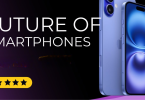Finding the top smartphones 2025 can feel like shopping for a tiny super‑computer that lives in your pocket. Below is a deeper dive than our last round: richer specs, fresh comparison tables, fuller benefits & drawbacks, and an easy wrap‑up. Skim or binge‑read—either way you’ll know exactly which handset fits your life.
What’s New in 2025?
| Trend | What it Means | Caveat |
| On‑device AI (Apple Intelligence, Google Call Notes, Galaxy AI) | Instant image editing, summaries, live transcription without cloud lag | Heavier RAM/storage use |
| Ultra‑fast charging (100 W+ becomes mainstream) | 0 → 100 % in ~40 min on some phones | More heat; proprietary bricks still common |
| Seven‑year update pledges (Samsung & Google join Apple‑style longevity) | You can hold a phone till 2032 without losing security patches | Battery wear is still the real limiter |
| Wi‑Fi 7 & Qi2 wireless everywhere | Routers and chargers you buy now won’t feel obsolete | Routers/chargers still pricey |
| Foldables mature | Z Flip 6’s cover screen can run full apps | Hinge durability & dust ingress remain weak points t |
The Flagships — Specs, Benefits & Drawbacks
All prices are US‑launch MSRPs for base storage.
1. Samsung Galaxy S25 Ultra – the Swiss‑Army Flagship

- Key Specs
- Benefits – unmatched zoom versatility; handwriting-to‑text with zero lag.
- Drawbacks – 219 g heft, S Pen’s Bluetooth remote was removed in 2025.
2. Apple iPhone 16 Pro – the Polished All‑Rounder
- Key Specs
- Benefits – class‑leading video, new Camera‑Control button, Apple Intelligence baked in.
- Drawbacks – pricey accessories and no desktop‑class USB‑C video‑out.
3. OnePlus 13 – Speed Demon with IP69
- Key Specs
Benefits – fastest charge of any mainstream phone; first IP69 rating.
- Drawbacks – only four Android version upgrades; very large body.
4. Google Pixel 9 Pro – AI First, Always
- Key Specs
- Benefits – exclusive AI tricks (Call Recorder auto‑summaries, Best Take).
- Drawbacks – slowest charging in the flagship pack; GPU still trails Qualcomm.
5. Xiaomi 15 Pro – Brightest Screen on Earth
- Key Specs
- Benefits – superb daylight visibility; big battery.
- Drawbacks – MIUI’s occasional ads and only four OS upgrades.
6. ASUS ROG Phone 9 – Gamer’s Paradise
- Key Specs
- Benefits – coolest thermals, best sustained frame‑rates, huge battery.
- Drawbacks – heavy (227 g) and short software lifespan.
7. Samsung Galaxy Z Flip 6 – Pocket‑Sized Foldable
- Key Specs
- 6.7″ inner + 3.4″ cover, both 120 Hz
- Snapdragon 8 Gen 3
- 4 000 mAh, 25 W wired
- Full apps on FlexWindow; 7‑year updates
- 6.7″ inner + 3.4″ cover, both 120 Hz
- Benefits – folds to half the height; outer screen runs Maps, Chat, Spotify.
- Drawbacks – hinge dislikes dust; battery smaller than slab phones.
8. Google Pixel 9a – Budget Hero
- Key Specs
- Benefits – flagship‑class photos and AI for half the price.
- Drawbacks – plastic back and glacial wireless charging.
Big‑Picture Benefits & Drawbacks of 2025 Flagships

| Benefit | Why You’ll Care | Typical Trade‑off |
| Laptop‑class AI | Image editing, call transcripts, on‑device ChatGPT‑style answers instantly | Higher base storage tiers (256 GB+) becoming standard |
| Crazy‑fast charging | < 45 min full charges are real | Proprietary cables/bricks; more heat |
| 7‑year update pledges | Real sustainability + resale value | Batteries will likely need replacement mid‑life |
| Brighter LTPO displays | Sunlight use finally painless | Can drain battery faster at max brightness |
| Foldables you can rely on | IP48 water seal, stronger hinge | Still vulnerable to dust & pricey repairs |
You may also like to read these posts:
https://techloomz.com/wp-admin/post.php?post=213&action=edit
https://techloomz.com/wp-admin/post.php?post=215&action=edit
https://techloomz.com/wp-admin/post.php?post=217&action=edit
https://techloomz.com/wp-admin/post.php?post=219&action=edit
Comparison Tables
1. Key Specs & Pricing
2. Battery & Charging Performance
3. AI & Software Support
Final Thoughts
The top smartphones 2025 move in refinement steps, not revolution: smarter local AI, ultra‑fast charging, brighter screens, and near‑decade support windows. Pick according to extras:
- Stylus & pro camera? Galaxy S25 Ultra.
- Slickest video & eco‑system? iPhone 16 Pro.
- Speed demon charging? OnePlus 13.
- AI wizard & compact body? Pixel 9 Pro.
- Daylight‑proof display? Xiaomi 15 Pro.
- Ultimate gaming? ROG Phone 9.
- Jeans pocket foldable? Z Flip 6.
- Value king? Pixel 9a.
Whichever you choose, you’re future‑proofed well into 2030—and you’ll spend less time at a wall‑socket than ever before.
📱 FAQs
Q1: Which is the best overall smartphone in 2025?
A: The Samsung Galaxy S25 Ultra is considered the best all-around smartphone in 2025. It has the most versatile camera system, built-in S-Pen for productivity, powerful performance, and a stunning display. However, it’s also one of the most expensive and bulky phones.
Q2: What is the best smartphone for photography in 2025?
A: If photography is your main concern:
Samsung Galaxy S25 Ultra is best for zoom and versatility.
iPhone 16 Pro offers excellent video recording and lifelike colors.
Pixel 9 Pro has smart AI photo editing like “Best Take” and Magic Editor.
Q3: Which smartphone has the best battery life in 2025?
A: OnePlus 13 and Xiaomi 15 Pro are top choices. They come with 6,000 mAh+ batteries and support super-fast charging (up to 100W). Both easily last more than a day with moderate to heavy use.
Q4: Which smartphones are getting the longest software support?
A:Pixel 9 Pro and Pixel 9a: 7 years of OS and security updates.
Galaxy S25 Ultra and Z Flip 6: 7 years of OS/security updates.
iPhone 16 Pro: Typically 6–8 years based on Apple’s track record.
Q5: Are foldable phones reliable in 2025?
A: Foldables like the Galaxy Z Flip 6 have come a long way and are now water-resistant (IPX8), but dust protection is still weak. You should avoid sandy or dusty environments, and they may still not match slab phones for durability.






